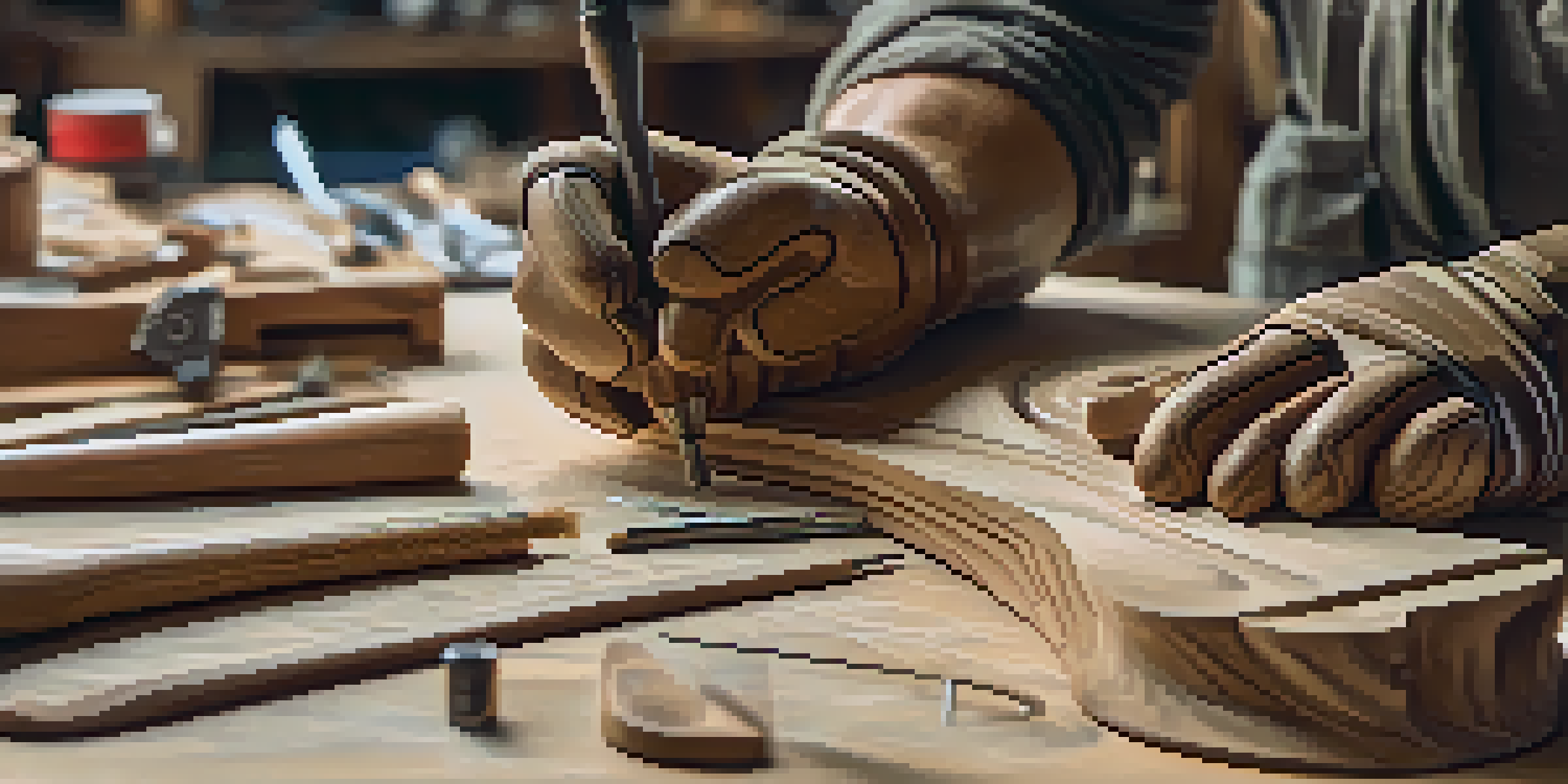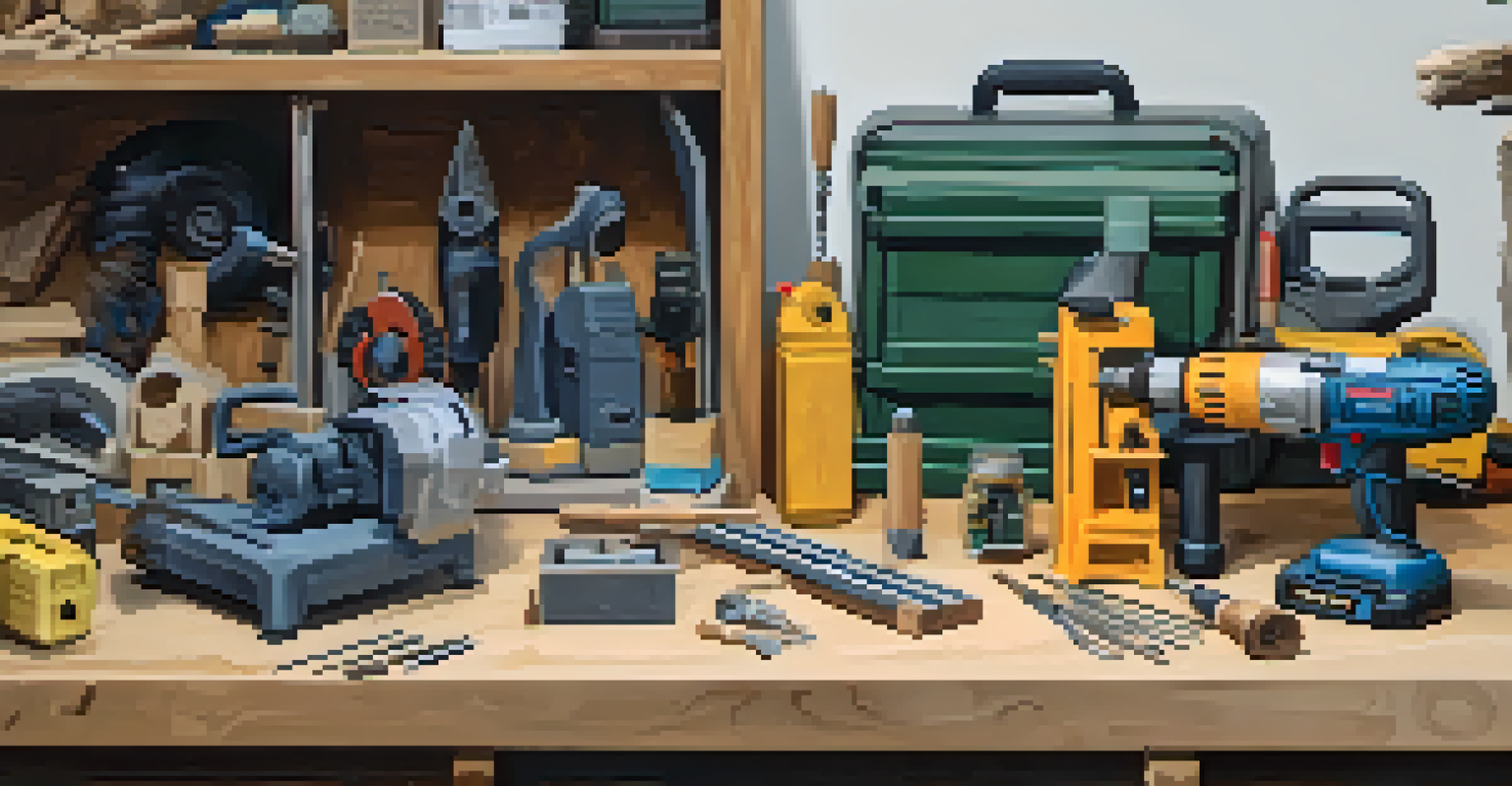Using Power Tools in Sculpture: Tips for Efficient Carving

Choosing the Right Power Tools for Your Sculpture
Selecting the right power tools is crucial for effective sculpture carving. Different tools serve specific purposes; for instance, rotary tools are excellent for detailed work, while chainsaws are better for large, rough cuts. Understanding what each tool can do will help you choose the best one for your project, ensuring you achieve the desired results efficiently.
The sculptor's tools are the instruments of his art, and like a musician, he must learn to use them with precision and care.
Moreover, consider the material you'll be working with. Whether it's wood, stone, or metal, each material requires different tools and techniques. For example, a stone carving might call for diamond-tipped bits, while wood can be shaped easily with oscillating tools. Researching your material beforehand can save you time and frustration.
Finally, don't forget about safety features and comfort. Look for tools that have ergonomic designs and safety guards to protect your hands and eyes. Investing in high-quality tools not only enhances your carving experience but also ensures your safety while you unleash your creativity.
Essential Safety Tips When Using Power Tools
Safety should always be your top priority when using power tools. Start by wearing appropriate protective gear, such as goggles, gloves, and a dust mask, to shield yourself from flying debris and harmful dust. It's easy to get caught up in the excitement of carving, but a moment of carelessness can lead to serious injuries.

Additionally, familiarize yourself with the tools before you start working. Read the user manuals, watch instructional videos, or even take a class to understand the best practices for each tool. Knowing how to operate your equipment safely can prevent accidents and enhance your carving skills.
Choose Tools for Your Material
Selecting the right power tools based on the specific material—wood, stone, or metal—ensures effective and efficient carving.
Lastly, always keep your work area clean and organized. Clutter can lead to accidents, so make sure your tools are stored properly and the space is free of obstacles. A tidy workspace not only promotes safety but also helps you focus on your creative process.
Mastering the Art of Tool Techniques for Carving
To carve efficiently with power tools, mastering various techniques is key. Start with basic movements, such as pushing and pulling, and gradually incorporate more complex patterns. For instance, using a rotary tool, you can create intricate designs by varying your speed and pressure, which will bring depth to your sculptures.
Art is not what you see, but what you make others see.
Practice makes perfect, so don't hesitate to experiment with different tools and techniques on scrap materials. This trial-and-error approach allows you to develop a feel for the tools, enabling you to work more confidently and creatively on your final piece. Remember, every great sculptor started as a beginner, so embrace the learning curve.
Additionally, consider the direction of your cuts carefully. Cutting against the grain or in the wrong direction can lead to chipping or splintering, which can ruin your work. By choosing the right angle and technique, you’ll achieve smoother finishes and greater control over your carving.
Maintaining Your Power Tools for Longevity
Proper maintenance of your power tools extends their lifespan and ensures optimal performance. Regularly check and clean your tools after each use, removing any debris or buildup that could hinder functionality. A simple routine can make a significant difference in how well your tools work over time.
Also, pay attention to the blades and bits. Dull tools can lead to poor results and can be more dangerous to use. Make it a habit to sharpen or replace blades as needed, and always keep a backup set handy for those moments when you need to switch quickly during a project.
Prioritize Safety When Carving
Wearing protective gear and maintaining a clean workspace are essential for preventing accidents while using power tools.
Lastly, store your tools in a dry, organized space to prevent rust and damage. Proper storage not only keeps your tools in great shape but also makes them easily accessible when inspiration strikes. Treat your tools with care, and they’ll reward you with beautiful sculptures for years to come.
Planning Your Sculpture Project for Efficient Carving
A well-thought-out plan can streamline your carving process significantly. Start by sketching your design and determining the materials you'll need. Having a clear vision of your sculpture helps you stay focused and prevents unnecessary detours during the carving process.
Next, break down the project into manageable steps. This could involve outlining the rough shape, refining details, and finishing touches. By tackling your sculpture in stages, you can monitor your progress and adjust your approach as needed, making the entire experience less overwhelming.
Finally, allocate time for each phase of your project. Carving can be time-consuming, so giving yourself ample time for each step ensures you won't rush through any part of the process. Remember, patience is vital in sculpture, and taking your time will ultimately lead to a more polished and satisfying outcome.
Incorporating Creative Techniques into Your Carving
Once you've mastered the basics, it’s time to explore creative techniques that can elevate your sculptures. For example, consider using layering or texturing to add dimension and character to your work. You can achieve this by combining different carving techniques or even mixing materials for unique effects.
Another technique worth experimenting with is the use of color. Don't shy away from painting or staining your sculptures after carving; this can completely transform the final piece. Adding color not only enhances visual appeal but can also convey emotions and stories within your sculpture.
Plan Your Sculpture Project Well
A detailed plan that breaks down the carving process into manageable steps helps in achieving a polished final sculpture.
Additionally, look for inspiration from other artists or cultures. Studying different styles can spark new ideas and push you to think outside the box. By incorporating diverse influences into your work, you can develop your own unique artistic voice and style.
Sharing Your Sculptures: Tips for Display and Engagement
Once you’ve completed your sculpture, how you choose to display it can make a significant impact. Consider the setting where it will be showcased; lighting and background can enhance its visual appeal. A well-lit piece in a complementary environment draws attention and invites viewers to appreciate the details.
Engaging with your audience is equally important. Share your creative process through social media or local art shows, and don’t hesitate to tell the story behind your sculpture. This personal touch can resonate with viewers, making your work more relatable and memorable.

Finally, consider the possibility of selling your sculptures or collaborating with other artists. Building a network within the art community can open doors to new opportunities and allow you to share your passion with a wider audience. Remember, art is not just about creation; it's also about connection.